Get Creative in Drawing Ornaments!
This month, the focus is on art history. Art history is often talked about in a very serious tone, but let’s examine it through imagination and start by drawing ornaments!
Ornament Tells a Story from Childhood
It’s fascinating that even if the ornaments are stiff and organized compositions, one can express a whole story.
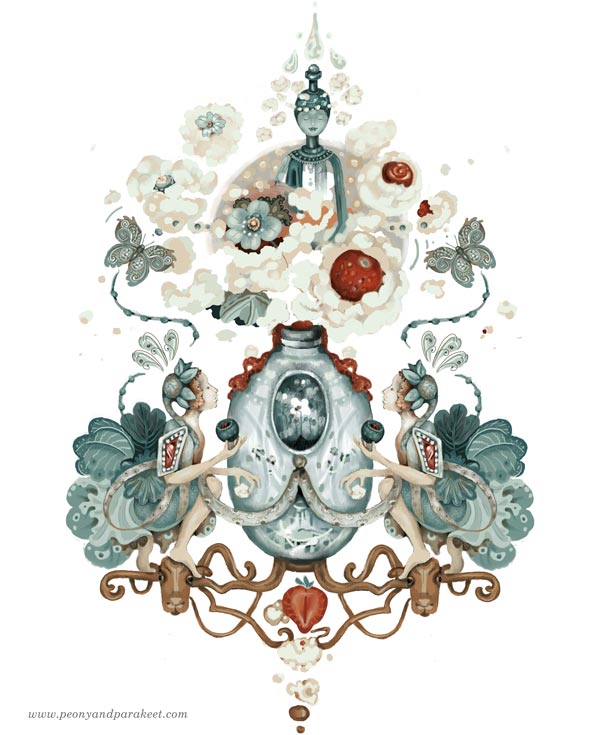
The background of this drawing is a funny story from my childhood. When the school asked each student’s favorite food, I answered “Mansikoita ja kermavaahtoa!” – Strawberries and whipped cream” while the others listed macaroni dishes or meatballs. Both the teacher and the students were quite shocked by the answer, but I wondered how anyone would prefer to eat something so modest and usual.
This story tells a lot about how I’ve always wanted to get away from the mundane. I still want to draw things so that they look like a luxurious celebration rather than a gray everyday life. I like drawing jewels, lace, floral motifs, and swirls, and you can have a lot of those on the ornaments.
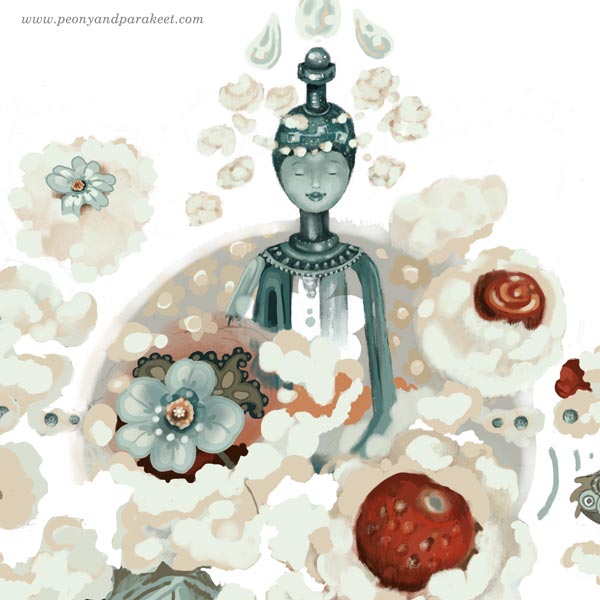
I often want to include people or animals too. For example here, I wanted to make the whisk half-human, and draw two fairies that enjoy the dessert.
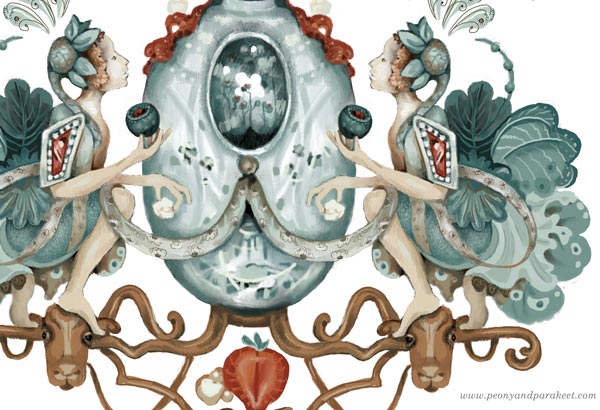
The method that I teach for human poses in the course Doll World was very helpful here.
Inspiration from Antiques, Old Buildings, and Paintings
There are plenty of ornaments in my photo archive. When I visit old buildings, I go through doors, ceilings, wall panels, and floors, looking for nice ornaments.
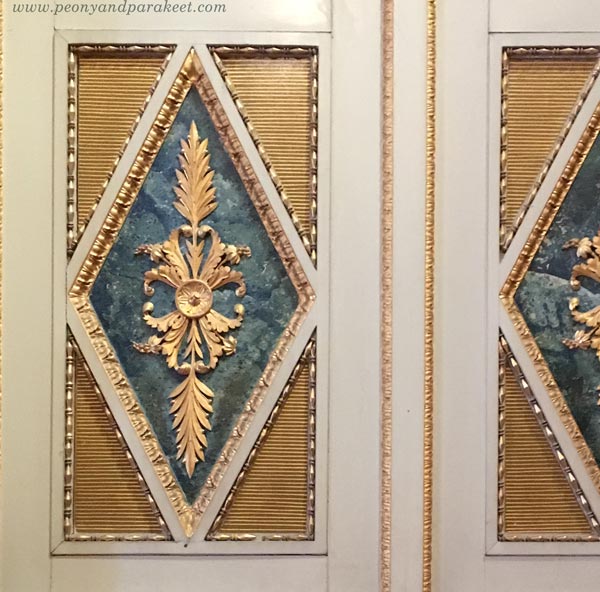
I also love to examine antiques closely.
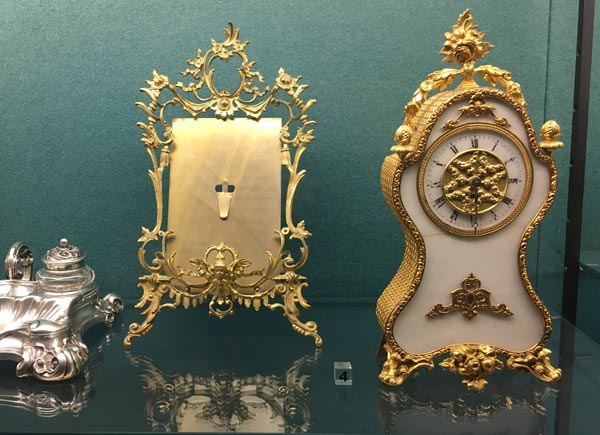
Old paintings often have lovely frames. Whenever I photograph one, I always try to include the frame in the picture.
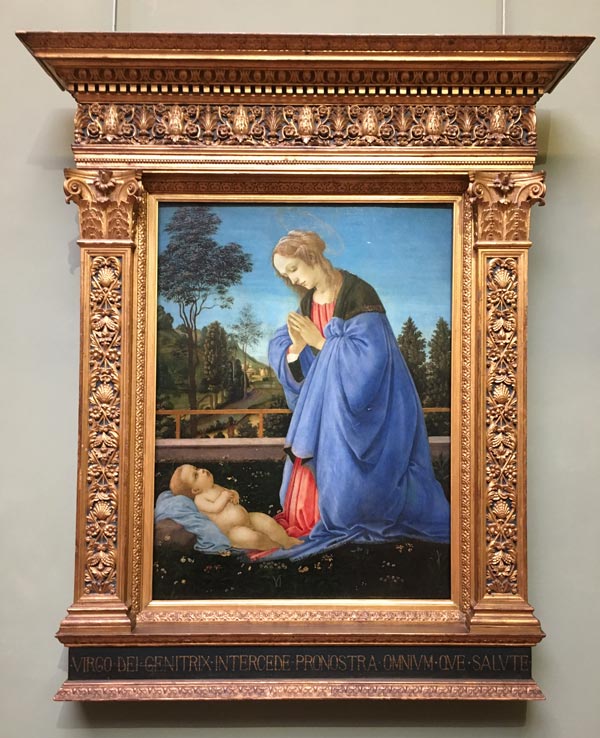
This frame is like an ornament representing a palace!
Lots of Simple Shapes
The decorative appearance of the ornaments can mislead you into overestimating their complexity. When an ornament is taken apart, the shapes can be quite simple.
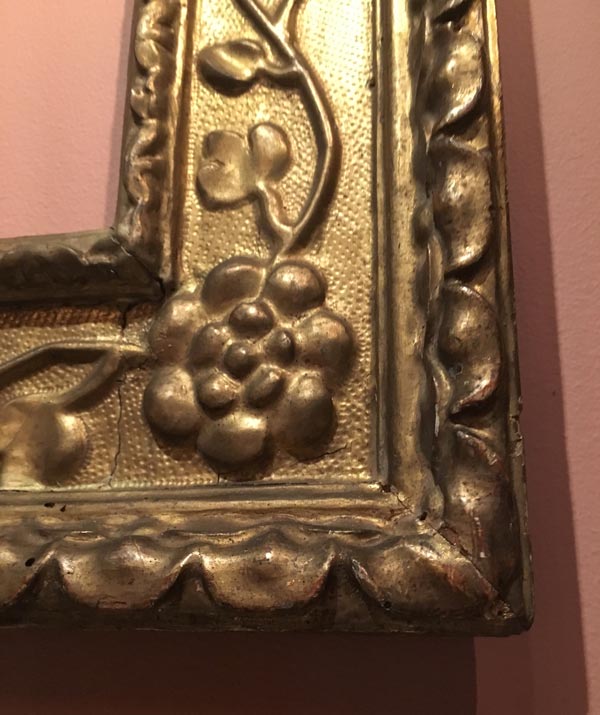
I love this kind of sophistication based on quantity and repetition, with which you can express anything – humorous subjects …
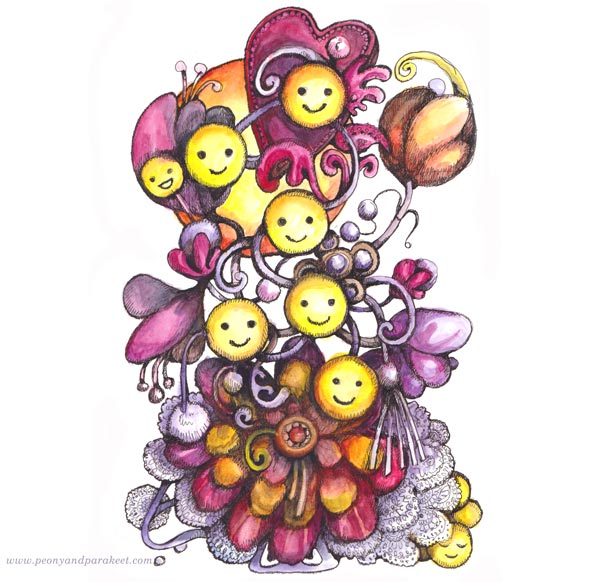
… or more serious.
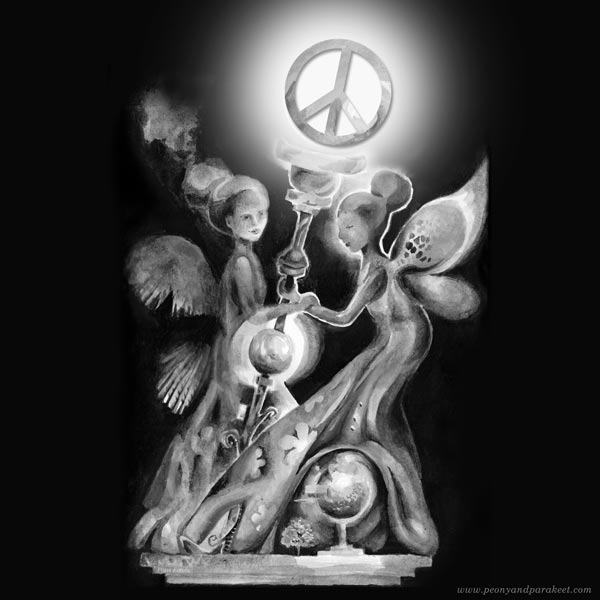
This example shows well that you can also express light when drawing ornaments.
Ornaments Can Both Hide and Reveal
I am fascinated by the fact that although the subject can be drowned in decorative forms, it can also be brought out more directly and more concisely than in a regular drawing. Time travel to the past can become surreal when the horizon disappears and the items are arranged as part of a floating structure.
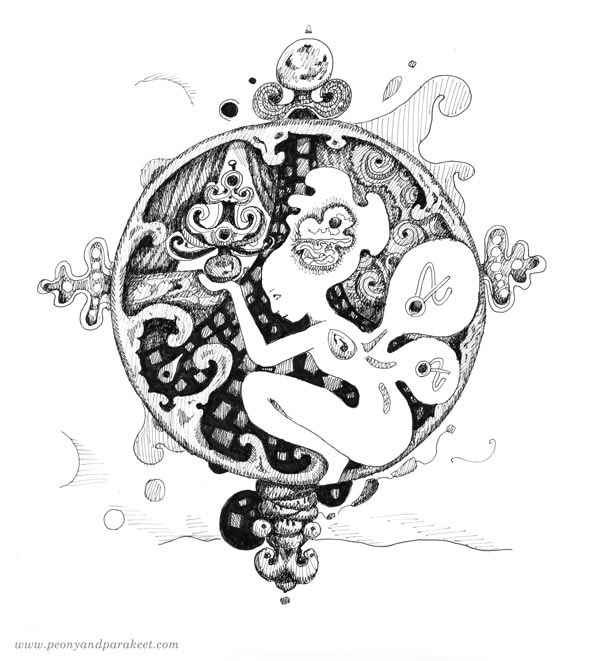
Ornaments as Collage Art
If drawing the whole ornament in one go feels too demanding, remember that the ornaments can also be collage art. You can glue individual elements so that they form a decorative tree or medallion. I have put together many kinds of ornaments from hand-drawn animals and hand-decorated papers.
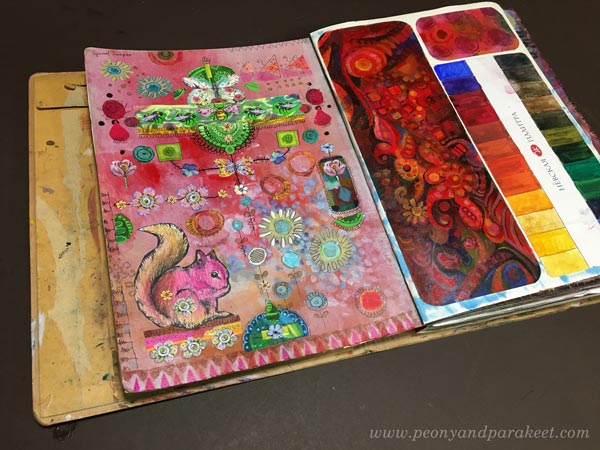
You can also scan or photograph the drawings and assemble the ornament digitally with an image processing program. Here are animal figures and flowers from the course Animal Inkdom and a teacup from the course Magical Inkdom.
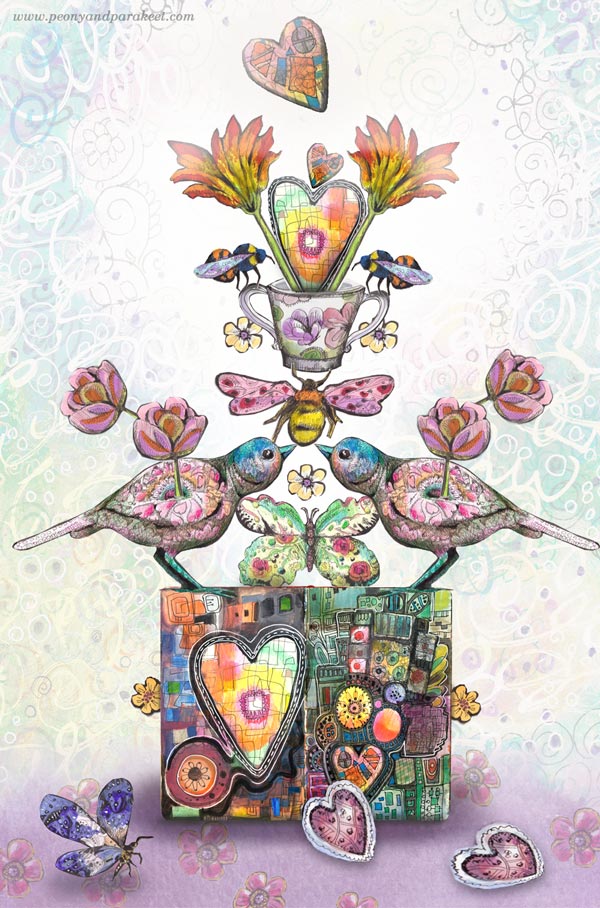
Drawing Ornaments is Expressing the World
After working with ornaments for a while, you begin to realize that the world is largely based on them. Surface patterns are everywhere. The beauty of organic forms can be found in all living things.
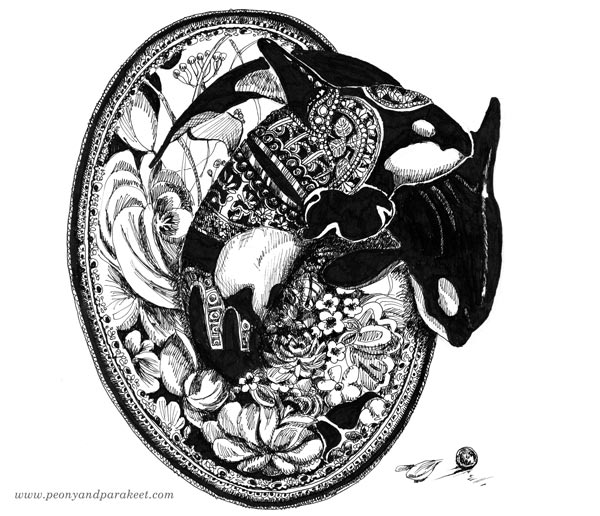
Ornaments build a bridge between the living and the non-living. They make the living an object and the object alive.
Hidden Love for Ornaments and How it Shows
I think that many of us have an innate need to design ornaments. Maybe you dream about designing fabrics or have a huge stash of them. Maybe you collect jewelry or save photos of them. Maybe you feel that something is lacking if you only draw or paint complete images and are not able to rearrange the composition so that it’s something more stylish and less representational.
I only realized this tendency of mine when I made ornaments as part of the illustration for a children’s book. Back then, I used transparent marker paper to design the symmetry, and my desk was full of different versions.
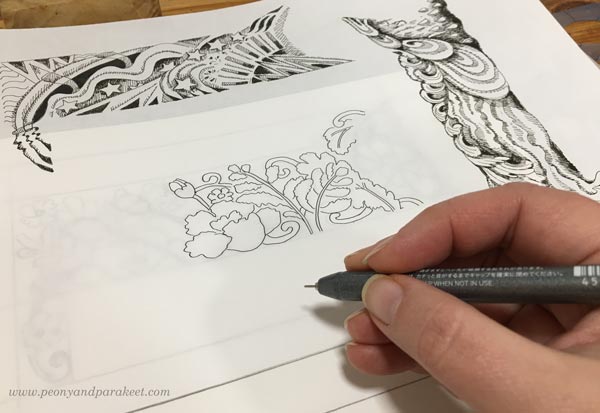
One day when picking the pen, I suddenly felt happy and meaningful: “I should do this more!” Since then, I have not underestimated even the smallest encounters with ornaments.
Drawing Ornaments Inspired by Embroidery
I relax from my work as an artist by doing cross-stitch and those projects also inspired me to draw ornaments.
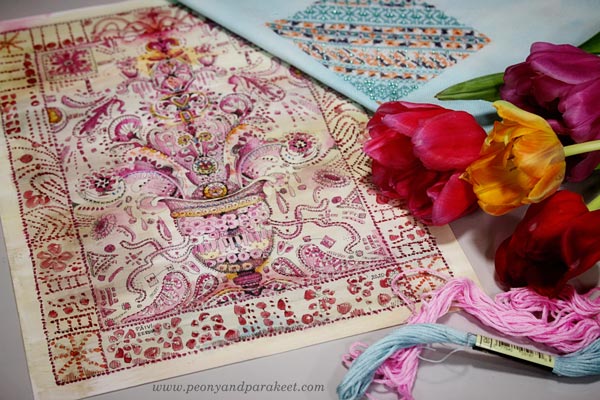
See here how to draw and color an embroidery-inspired ornament – Doodler’s Sampler Step by Step!
Drawing Ornaments without Perfect Symmetry
I drew the last ornament with the ProCreate app. The good things about it are that the background can be kept separate so that the background colors can be varied and it is easy to create symmetry. However, I think completely symmetrical ornaments are a bit too stiff and boring, so I also made quite a lot of asymmetry for this ornament.
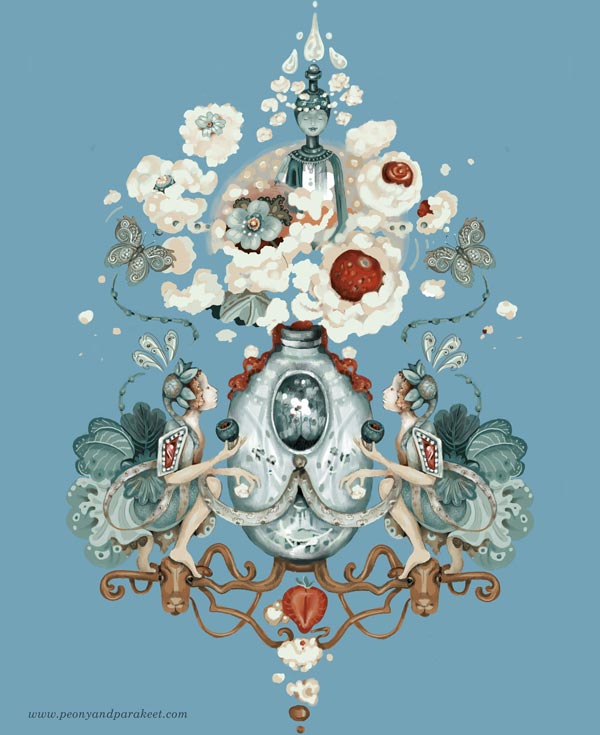
I hope you will start drawing ornaments right away whatever technique you choose!
Related Courses
- Doll World – drawing human poses – Buy here!
- Animal Inkdom – drawing animals – Buy here!
- Magical Inkdom – drawing fantasy – Buy here!
- Collageland – inspired by embroidery – Buy here!
Dolls and Angels – Video Blog Post
This week, I have a video blog post for you! I talk about dolls and angels – winter, the new class Doll World and Christmas memories, among other things!
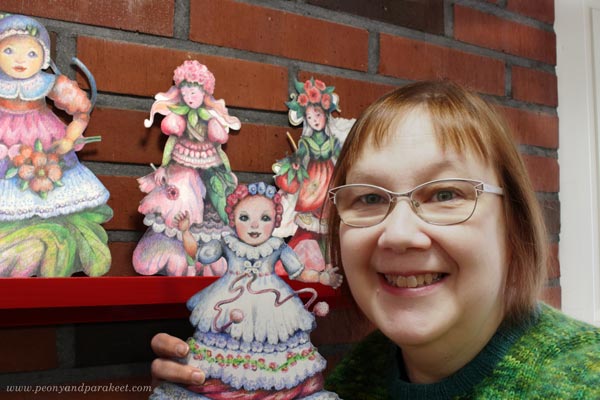
You will also see my table at the recent sales event. I hope you enjoy the video!
Dolls and Angels – Watch the Video!
Links to Related Blog Posts
- The previous video blog post
- Instructions for drawing a winter angel
- Preparing for the sales event
- The half-body figure: Creating a Protector of Good
- The painting: Winter Night’s Poem
- About painting a series: Inspired by Nature
Related Online Classes
- Doll World – Sign up here!
- Make a chapter for your colored pencil journal: Fun Botanicum
- The evolution from drawing to coloring and then to painting: 1) Inspirational Drawing, 2) Intuitive Coloring, 3) Floral Freedom
Expressing Winter Memories
This week, I have a new winter-themed painting, and we talk about the many approaches for expressing winter and memories of any season.
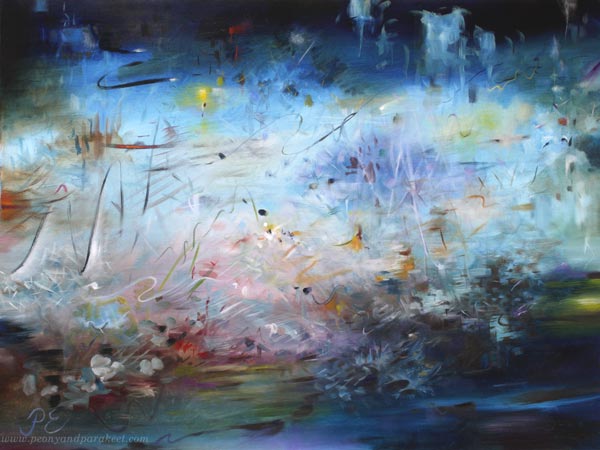
Here’s my newest painting called Winter Night’s Poem. This time, the Finnish name is much more beautiful: Talviyön runoelma. I wanted to give the painting a poetic name – like Shakespeare’s play “A Midsummer Night’s Dream – Kesäyön unelma” but something more wintery. So I come up with the Finnish name, which sounds so romantic (if you know Finnish that is!), and then translated it to English as accurately as possible.
I painted this piece for the local artist association’s winter-themed art exhibition. Winter sceneries aren’t really my thing, but I wanted to take the challenge. I started by exploring Japanese woodblock prints and made a small colored pencil study that is more like a fall scenery, but that has similar abstract elements than in the final painting.

I talked more about this colored pencil piece in October’s video blog post.
Winter Memories
I found it challenging to get emotionally connected with the theme. As Finn, I do know winters. They are cold and dark, and there’s not much that I enjoy about them. As a child, I lived further north, and winters were even colder and darker. Here’s a picture of me in 1974 when I was 5 years old.
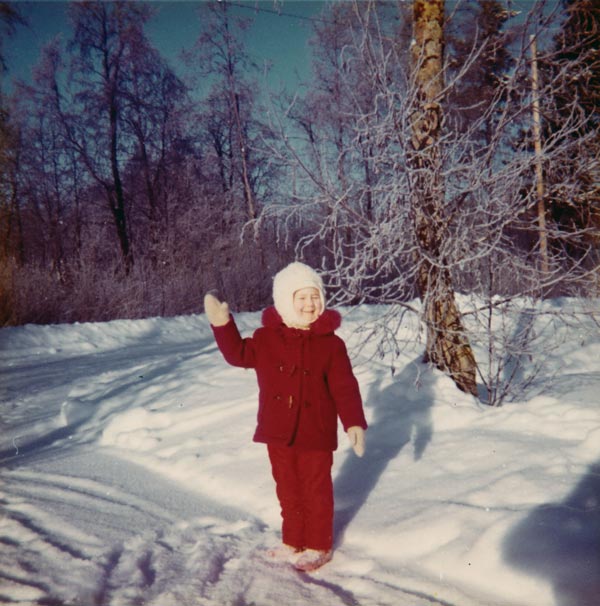
However, I have one special winter memory. Earlier this year, in one of the weekly emails, I wrote about Avicii‘s music and how it brings the memory to my mind:
When I hear A Sky Full of Stars, I am a little girl on a cold Tuesday evening in Eastern Finland. After participating in an icon painting group, I walked down the snowy hill looking up. The starry sky was blue-black, I realized. Not black like for those who glance carelessly or blue like for those whose skies were always blue. Working with colors had made the world look more beautiful.
I also remember getting an idea for a poem that I later wrote down. It was something about the starry sky. And there was a melody too. The sight, the words, and the sounds all formed this beautiful winter memory. And isn’t it so that memories are full of sensations of all kinds? Why should we then paint only what we see?
But then I heard myself saying: “Paivi, remember that it’s a winter-themed exhibition. It has to look like winter!”
How Does Winter Look Like?
In 2013, I made this hand-drawn collage for Christmas cards. It has a decorative approach to winter. Snow, hearts, berries, pastel colors – they all form a light-hearted and entertaining take on winter.
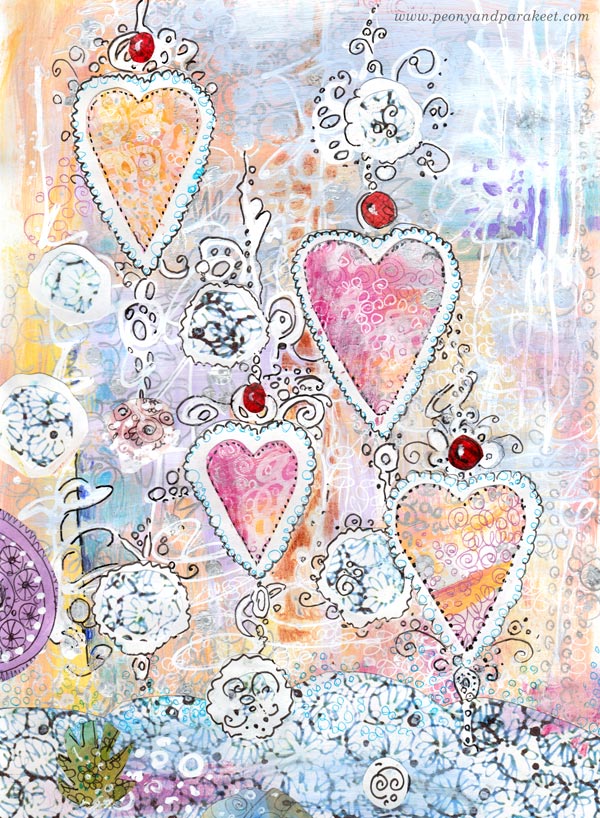
An even more obvious choice would be to paint a realistic winter scenery with snow, trees, and such. Here’s a watercolor painting from 2018:

My idea was to paint both fall and winter into the same piece. This is a class project from Watercolor Journey where we paint all kinds of sceneries in watercolor.
Winter in a Poem
But the more I thought about winter, the more connection I felt with the abstract side of it. I didn’t want to just paint an empty-looking scenery in black and white. I wanted the lights and darks to have a rhythm.
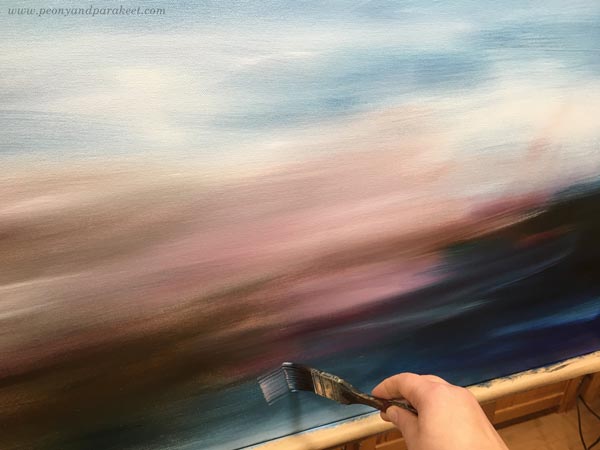
My favorite poet Eeva-Liisa Manner has a winter poem that I have read hundreds of times because it was in a little poem book my family had. For a small child, the content felt strange, but the more I read it and the more I grew, I fell in love with its rhythm. The poem doesn’t rhyme, it’s free verse, very modern. But still, when I read it, I feel the rhythm, and when it ends, it feels like you have listened to a song, not read a poem. The words have been thrown into the air, carelessly, and yet, it feels like everything has a purpose. It’s like every word would have fought to get into to poem, and after accepted, they are ready to fly beautifully, each on their turn, and then to get mixed up even more elegantly in the reader’s mind.
Maybe you too, love poetry and have experienced the same. The words glow like jewels and have a long effect even if the time spend on the reading, is just a minute or two. Isn’t that what we aim for in visual art too?
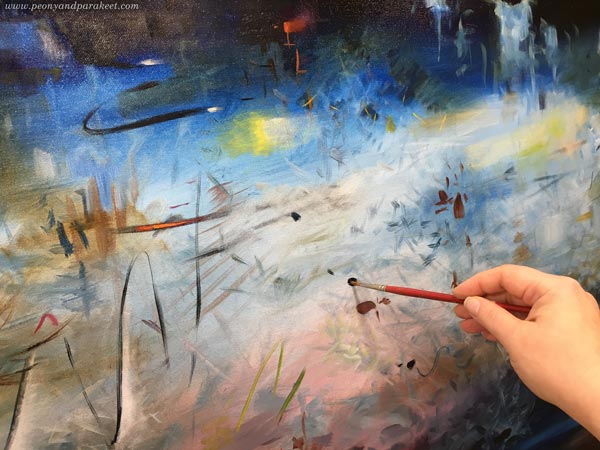
Wonders of a Winter Night
More than thinking about realistic scenery, I approached the painting with a poetic mindset. I imagined the sounds and rhythm of a winter night and visualized those. I trusted that the result will look wintery even if the painting is abstract.
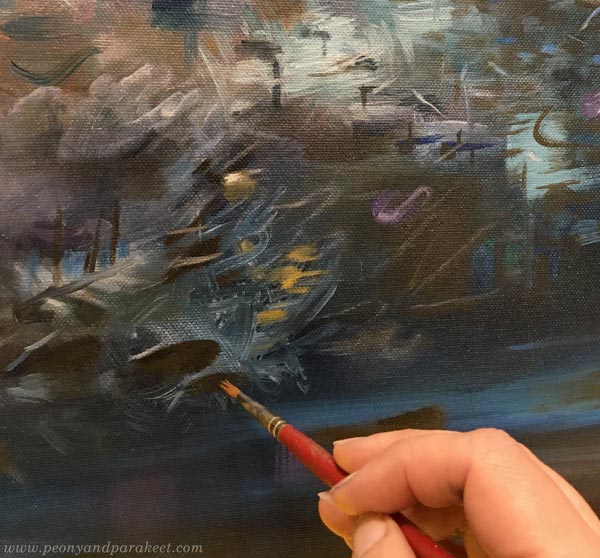
I also thought about how things move, and one of my favorite details is the curvy black wind that blows snow.
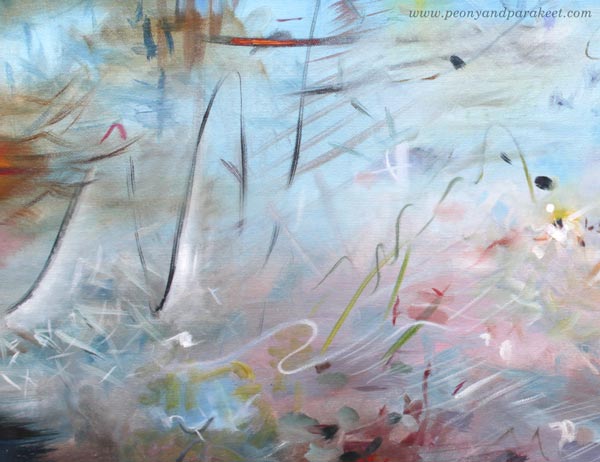
Carelessly painted ice-like objects are on the top, and the sound of ice is visualized below them.
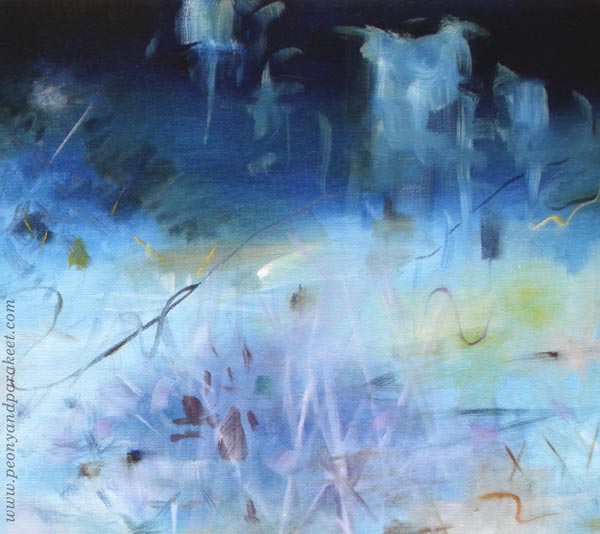
Probably the childhood memory of the winter night has stayed with me because it’s a little bit scary to walk alone in the cold and in the dark, under a few street lights only.
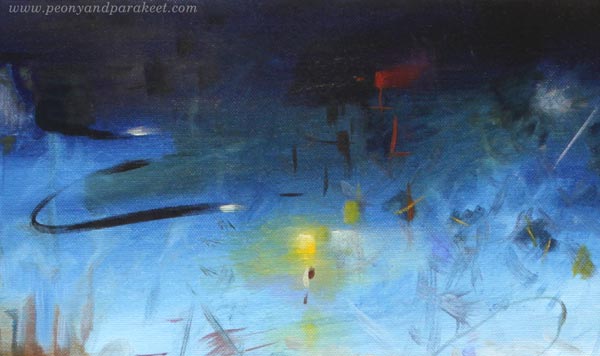
The color scheme was one of the challenges. I didn’t want the painting to look off-puttingly cold. Instead of only using blue and white, I brought a wide variety of tones but so that most of them are quite dark or pale.
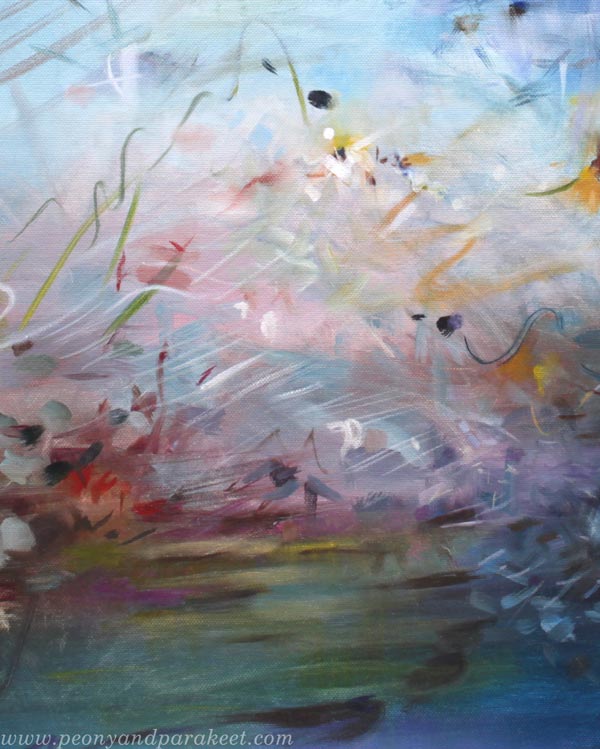
Fortunately, winter is not here yet, but usually, we have the first snow in November. So the garden scenery will change soon!

I hope this blog post inspired you to express winter or any season that you have fond memories of!
Draw a Coloring Page and Color It Creatively!
This week, we draw a coloring page and color it creatively.
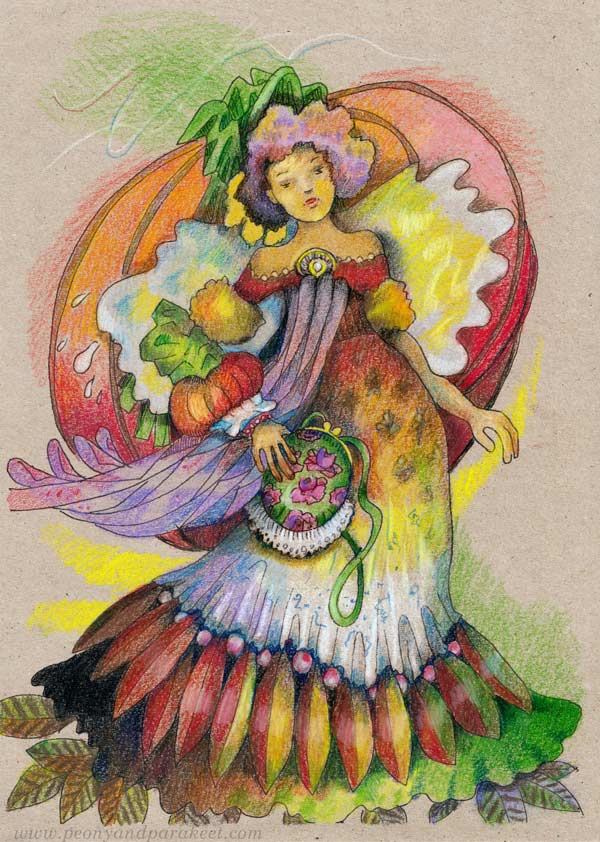
Inspiration from an Artist Friend Eeva Nikunen
This blog post is inspired by my artist friend Eeva Nikunen. She is a master at drawing coloring pages. She has many self-published books, and just recently, she drew the Alice in Wonderland coloring book for a famous British company Colouring Heaven. I especially love Eeva’s illustrations of men, and her drawing skills are superior, much further than mine. Of the two of us, she is more of an illustrator while I am a painter, but we both alternate with drawing and painting.
Inspiration from Historical Styles
The Victorian era inspires Eeva, and I love it too. In 2020, I illustrated a book called Fairy Experiments for Thinkers and Tinkerers. It had over 60 Victorian-style line drawings and one simple coloring page as well. I have used a similar drawing style in the classes Animal Inkdom and Magical Inkdom.
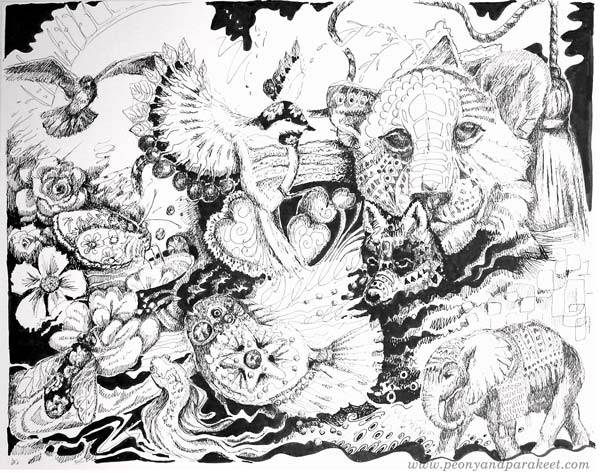
I also like Art Nouveau and Alphonse Mucha‘s illustrations. See this old blog post from 2015 where I draw in Art Nouveau style!
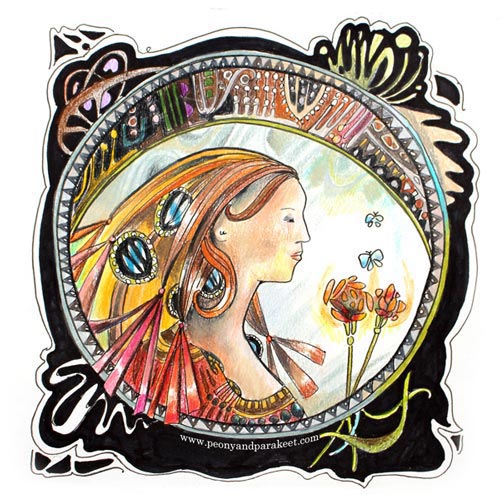
The blog post has a short drawing video too.
Art Nouveau has inspired me to create a set of coloring pages for the e-book Coloring Freely. Here are some samples of them.
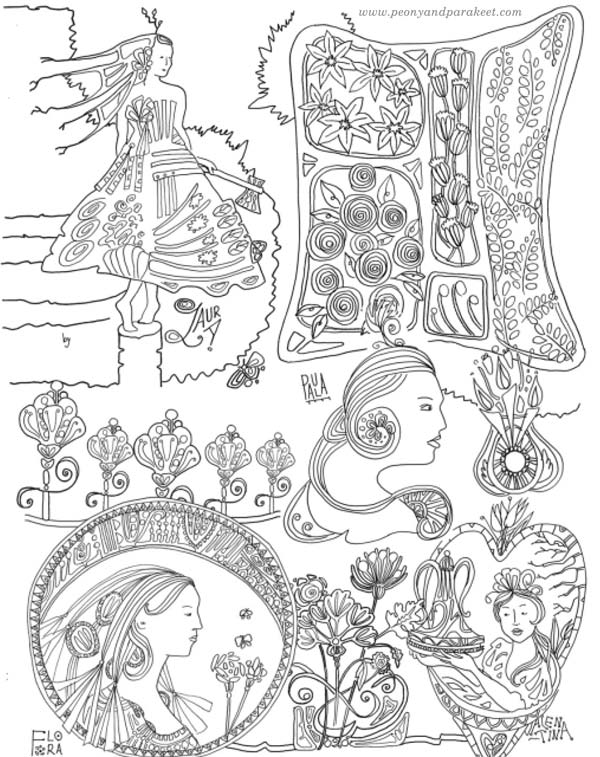
Let’s Draw a Coloring Page!
There are great programs for drawing coloring pages like ProCreate and Adobe Illustrator. I like these programs, but I like to keep drawing with pens and pencils too. So let’s look at how to draw a coloring page by hand!
I started with a pencil, and the focus was first on the pose. When I had a rough idea of a woman romantically entering a scenery, I drew over the pencil lines with a black drawing pen. I like to use ink pens because I draw better when I can’t erase the lines. It makes me concentrate more, and my hand becomes steadier.
The sketch for the pose is number 1 in the photo. I think many of you would just throw it in the trash and think that the project is a disaster, but the secret is to keep going by tracing the sketch to another paper.
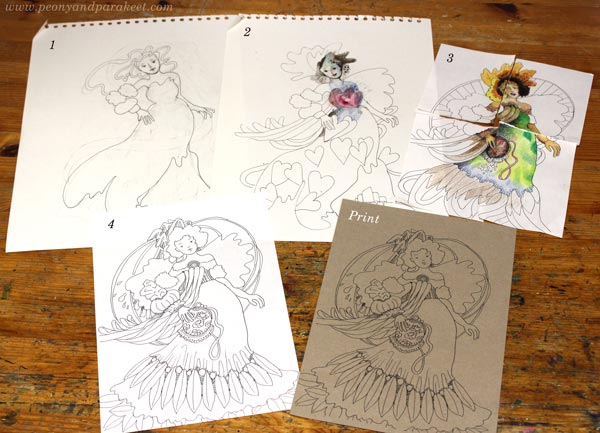
When tracing the old lines, you will get more ideas and new energy for adjusting the drawing. My second sketch had more elements, and I also started thinking about the facial expression of the character. When I ran out of ideas, I just drew hearts. Then I colored the sketch a bit to think about what the general idea of the image could be.
I like to develop ideas by drawing and coloring, not by thinking only. Many say they have images in their head, but mine are often too vague or too traditional. Drawing makes me more inventive and detailed. So, in the third sketch, the hearts were gone, and the lady had a bag, a leaf skirt, and a circle behind her. As you can see from the picture above, I threw the sketch away, but then when I thought about the blog post, I dug it out from the bin for the photo!
Here’s the third sketch without colors and the final version that I drew after coloring the third one for some time.
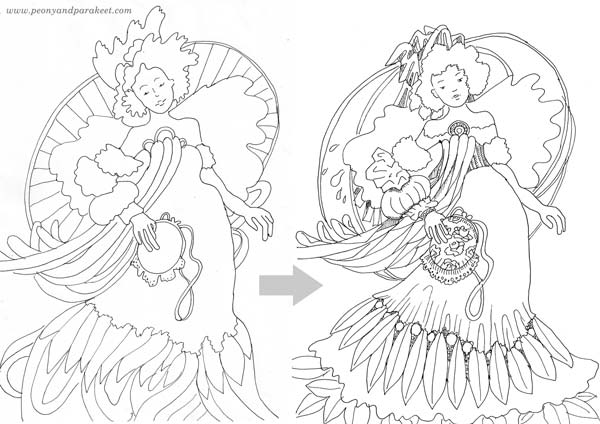
The final drawing is about saying goodbye to summer and hello to fall. The bag symbolizes summer and the circle became a giant pumpkin. If you compare my lines between the sketches, they become more delicate and detailed towards the end. The first sketch is a clumsy thing, but by redrawing the lady several times, I was able to make the design more flowing. Straight lines became curvier and curves got more notches, making the shapes more interesting. By leaving some of the elements visible only partly, the image looks more coherent and less floating.
Choosing Paper for Drawing and Coloring
The thin and smooth marker paper makes tracing easy. I got to know it when I was studying as an industrial designer. Art supply stores sell it. For coloring, I prefer thicker paper, so I scanned the image and printed it on a brown drawing paper.

Unbleached paper allows me to color a bit more carelessly and playing with pastels and whites is more fun.
Creative Coloring
An inspiring coloring page is not too detailed. I like pages that have some detailed elements, like the bag in mine, but that also have plenty of space for additional ideas. Then the coloring page can be treated as a foundation for creative coloring. For example, my page has pretty empty hem, and I can have fun by coloring freely – creating color changes and motifs that make the design more rich and stylish.
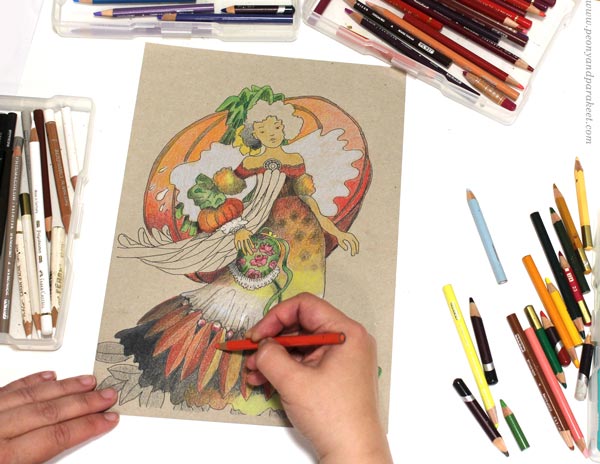
I also like to color over the lines so that coloring extends the original design.
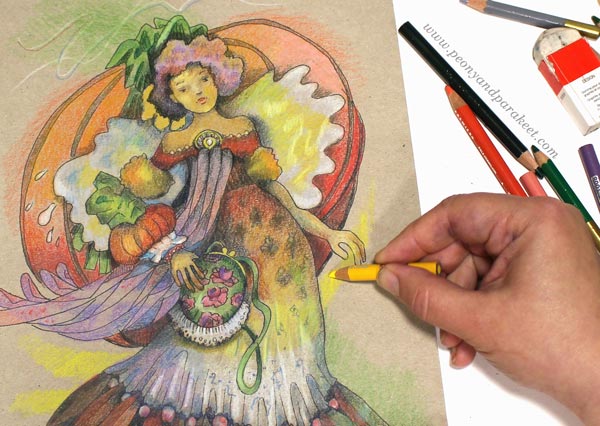
Compare the coloring page and the colored version below to see the additions made with colored pencils only!
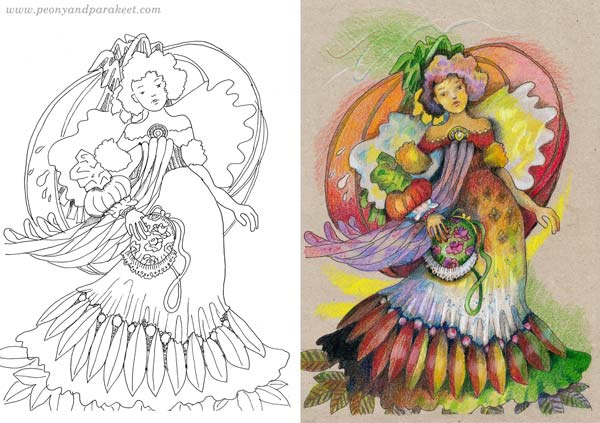
With colors, you can also change the style of the drawing. I think mine looks quite Alphonse Mucha without colors, but after coloring, less so. I like coloring shadows and making the design less flat than what Art Nouveau had.
The Intuitive Part of Intentional Art
After finishing a drawing that was born pretty intentionally, I like to ponder what had initiated it. I found this photo on my phone, taken a couple of days ago. The two-colored leaves looked so beautiful and bittersweet to me that I had snapped a picture of them.
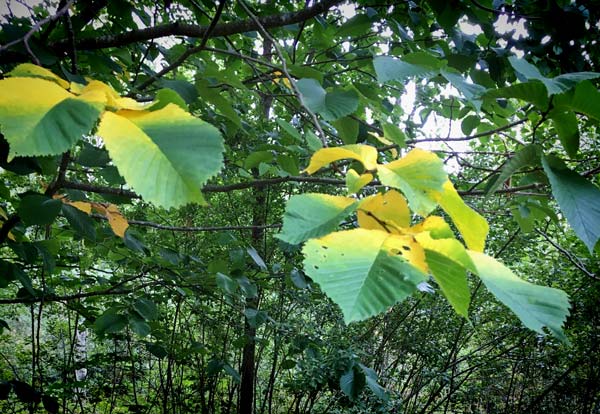
I am sad that summer is over but also acknowledge that summers and falls are not separate. One carries the other. It’s not fall’s fault that the summer is gone, and the present that the summer gave is dear to her.
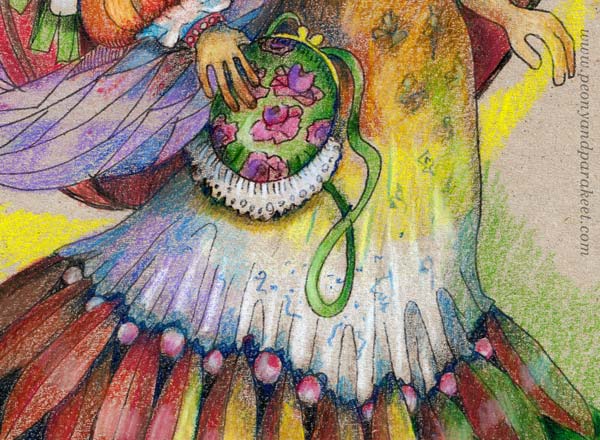
I hope this post inspires you to draw a coloring page through multiple sketches and then creatively color it!